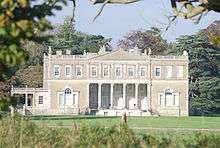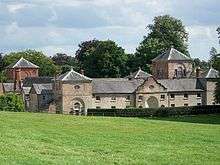Crichel House
Crichel House is a Grade I listed,[1] Classical Revival country house near the village of Moor Crichel in Dorset, England. The house has an entrance designed by Thomas Hopper and interiors by James Wyatt. It is surrounded by 400 acres (160 hectares) of parkland, which includes a crescent-shaped lake covering 50 acres (20 hectares). The parkland is Grade II listed in the National Register of Historic Parks and Gardens.[2]


History
The original Tudor house, owned by the Napier family, was largely destroyed in an accidental fire in 1742 and was rebuilt by John Bastard of Blandford and Francis Cartwright for Sir William Napier.[3] Humphrey Sturt, of Horton, in Dorset, acquired the estate in 1765 on his marriage with Diana, the aunt and heir of Sir Gerard Napier, the 6th and last baronet and extensively remodelled the house. The Bastard family collaborated to enlarge the shell of Crichel in 1771-73; the new interiors were designed by James Wyatt (1772–80), with painted decor by Biagio Rebecca, chimneypieces by John Devall, and furniture by John Linnell (1778–79) and Ince and Mayhew (1768–78).[4]
Further construction in the 19th century included an entrance designed by Thomas Hopper in 1831, and alterations by William Burn,.[5] A wing on the north side of the house was demolished in the 20th century, when many country houses were reduced in size.
From 1946 to 1961, Crichel House was the home of Cranborne Chase School, a boarding independent school for girls, which relocated to New Wardour Castle, near Tisbury in Wiltshire.
Ownership
The Crichel Estate is notable for the Crichel Down Affair, where the owners, Toby and Mary Anna Marten took on the Government and won the right to buy back land bought by compulsory purchase.
The house and estate is part owned by the Marten family, direct descendants in the female line of the 3rd and last Baron Allington. Other landowners with an interest in the estate are Richard Chilton and the Phillimore family. [6]
Relocation of Moor Crichel
The remodelling by Humphrey Sturt involved moving the village of Moor Crichel a mile to the south and many of the villagers were moved to Witchampton. This was so that the parkland could be landscaped and the original site of Moor Crichel is now submerged beneath the lake. Humphrey Sturt stopped short of moving St Mary's Church, which remains today.
Notable residents
George IV, while Prince Regent, stayed at Crichel House. Princess Charlotte Augusta of Wales, the only child of his loveless marriage with Caroline of Brunswick, made Crichel House her home for a time under the care of Lady Rosslyn and Lady Ilchester.[7]
Notes
- Historic England. "Crichel House (1120155)". National Heritage List for England. Retrieved 21 July 2015.
- Historic England. "Crichel House (1000716)". National Heritage List for England. Retrieved 11 February 2016.
- John Cornforth notes payments, starting in 1744, to Bastard and also to Francis Cartwright (Cornforth, "The Building of Crichel" Architectural History 27, Design and Practice in British Architecture: Studies in Architectural History Presented to Howard Colvin [1984], pp. 268-269).
- Cornforth 1984 noted payments to Wyatt 1772-80, "R. Biagio" 1776, J. Devall, Linnell and Ince and Mayhew.
- Colvin, 1995 sub "William Burn", "Thomas Hopper".
- Shrubsole, Guy. "The ten landowners who own one-sixth of Dorset". Who Owns England?.
- "Feudal Lordship of Winterborne St Martin". Archived from the original on 10 July 2012. Retrieved 30 May 2013.
References
- Howard Colvin, A Biographical Dictionary of British Architects 1600-1840 3rd ed. (New Haven: Yale University Press) 1995.